Longidorus breviannulatus
Norton & Hoffmann, 1975

Measurements (Female Holotype): L = 4,875 um; a = 100; b = 18.8;
c = 132; odontostyle = 85 um; spear extension = 35 um; tail
= 37 um; V = 46.4; guiding ring from anterior of nematode = 24 um.
(14 Female Paratypes): L = 4,755 um (4,019-5,151); a = 94 (86-114);
b = 16.9 (12.3-23.8); c = 123 (111-143); V = 46.7 (43.1-50.2); odontostyle
83.2 um (81-88); spear extension 35 um (28-45); guiding ring
from anterior of nematode = 23 um (21-26).
(Juveniles): Measurements of 15 juveniles are provided in Table
1. As with other species of Longidorus, the a, b, and
c values generally increased with increasing length of the nematode.
Description: Males unknown. Female body often in loose
open C when relaxed by gentle heat, but sometimes irregular. Body
slender, of uniform width 50 um (49-54) except for tapering extremities
and, frequently, a slight protrusion at vulva. Lips flattened, set
off by a knob-like expansion. Wide bilobed amphidial pouches extending
nearly to or reaching guiding ring. Amphidial apertures obscure, just behind
lateral lips. Cuticle and subcuticle 2 um thick for most of
body length, becoming thicker at extemities, markedly so at tail.
Hemizonid 159 um (150-173) from anterior end and seen best on fresh
nematodes, or those relaxed and fixed in 5% formalin. Esophagus 292
um
(195-405), with anterior part often convoluted. Prerectum length variable,
but 3.4 (0.6-4.8) times body width. Rectum shorter than anal body
diameter. Tail conoid, but sometimes with short broad peg in adults.
Ovaries didelphic, reflexed. Vagina reaching about half-way across
body. Vulva slit slightly oblique posteriorly in most Iowa specimens.
The species name refers to the short distance between the guiding ring
and the anteior end of the nematode.
Type habitat and locality:
Holotype.- Female collected 28 June 1971 around corn roots on Robert
Erwin farm, Section No. 17, Jefferson Township; coordinates T-73N; R-2-W,
Louisa County, Iowa. Soil: 94% sand, 5% silt, 1% clay; pH 6.4; <1% organic
matter.
Paratypes.- 14 Females: Same data as holotype.
Diagnosis:
L. breviannulatus has close affinities with L. elongatus
(de Man, 1876) Thorne & Swanger, 1936, L. closelongatus Stoyanov,
1964, L. tarjani Siddiqi 1962, and L. vineacola Sturhan
& Weischer, 1964. It can be differentiated from all of these by the
more forward position of the guiding ring. It is further differentiated
from L. elongatus by the wide bilobed amphidial pouches, and the
less conical tail; from L. closelongatus by the shorter stylet;
ffrom L. tarjani by the shorter body, shorter odontostyle, and tail
shape; and from L. vinecola by the much shorter body and tail shape.
In Iowa, the nematode is known from Lee, Louisa, and Muscatine counteis,
all of which border on the Mississippi River.
(Description- Norton & Hoffmann, 1975)
DNA Sequences Obtained



